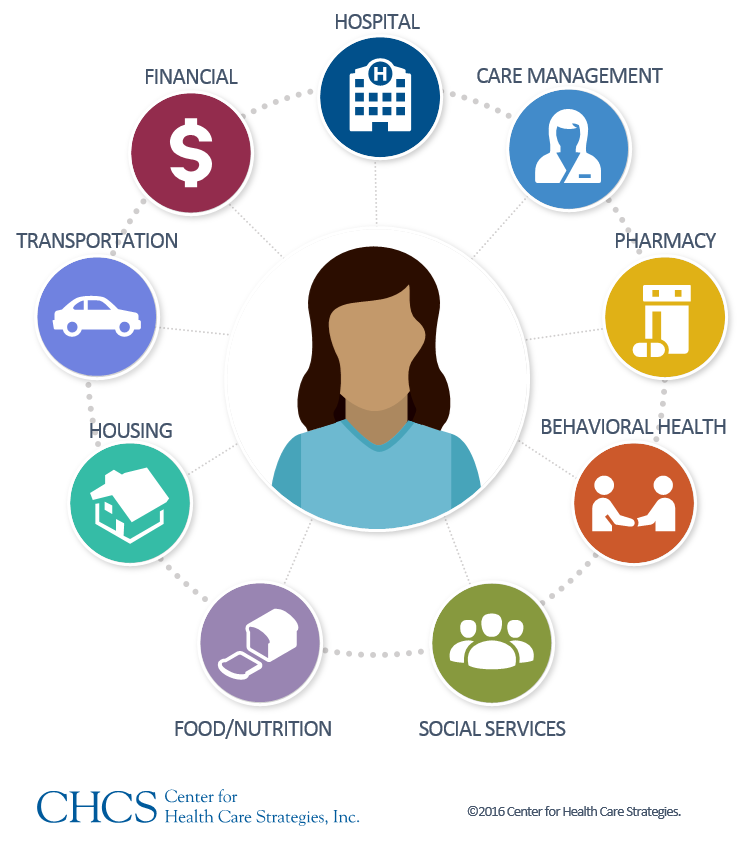Social determinants of health, including income, employment status, and access to healthy food and transportation, account for as much as 40 percent of individual health outcomes. Increasingly, states are recognizing the importance of interdisciplinary care teams and community linkages to address medical concerns as well as these social needs. These care teams can help achieve healthy outcomes, bend the cost curve, and improve patient satisfaction by extending care beyond the walls of a medical office. One specific model, community care teams (CCTs), is worth a closer look.
 What are Community Care Teams?
What are Community Care Teams?
CCTs, also referred to as community health teams or interdisciplinary care teams, are locally based, multi-disciplinary groups of care providers. In contrast to traditional care teams that focus solely on patients’ clinical needs, CCTs address medical issues and the social determinants of health. CCTs assist with health management, facilitate communication between patients and providers, assess social and non-clinical barriers to health, and connect patients to appropriate treatment and other needed resources. While the structure of CCTs may vary by state and by community, CCTs generally incorporate a range of clinical and non-traditional health providers such as community health workers, peers, and navigators. The teams facilitate patient-centered health care and social service connections that are culturally appropriate, high-quality, and cost-effective.
Statewide Community Care Team Initiatives
Over the past 10 years, a number of states have scaled and spread CCTs. For example, statewide initiatives are underway in Maine, North Carolina, and Vermont and they are beginning to show improvements in health outcomes.
Maine
Maine launched eight CCTs throughout the state in early 2012 as part of a value-based purchasing strategy under its multi-payer Patient Centered Medical Home (PCMH) program, which creates partnerships between CCTs and primary care practices. Maine expanded its existing PCMH efforts through the establishment of a health home practices (HHP) initiative for eligible Medicaid beneficiaries with chronic conditions. The CCTs provide wrap-around supports and services to help the HHPs manage care for the most complex, highest-need patients. The care teams use a short-term intervention approach — averaging between 30 to 90 days — and are composed of physician-hospital entities, behavioral health organizations, social service agencies, and federally qualified health centers. Maine requires its teams to report on PCMH Core Expectations quarterly to assess the implementation of patient-centered standards and to ensure accountability.
North Carolina
Community Care of North Carolina (CCNC) is a public-private partnership between regional networks of physicians, nurses, pharmacists, hospitals, health departments, social service agencies, and community-based organizations. CCNC provides cooperative, coordinated care through the state’s Medical Home model, targeting the highest-risk patients and working to better manage their health and use of primary care services. Patients who have high hospital costs, emergency department use, and readmissions are identified through referrals, claims review, and screening and assessments. Care teams visit patients’ homes within three days of hospital discharge to help create a plan for recovery and management of health conditions. This visit also gives patients an opportunity to ask questions about their treatment or illness.
Vermont
The Vermont Chronic Care Initiative is a statewide program that provides intensive care coordination and case management services to Medicaid beneficiaries with one or more chronic conditions. The focus is on the top five percent utilizers of the health care system. The program’s health teams include: a part-time medical director; registered nurses serving as care coordinators in provider practices and medical facilities; social workers; administrative staff; and a pharmacist. Through the health teams, eligible individuals receive assistance with social service needs and medication management. The teams also help in transitioning from emergency department visits and hospital stays to home and community settings.
Looking Ahead
Policymakers are increasingly aware of the need to address patients’ social and clinical concerns. CCTs offer one promising strategy for doing so. Payment models for CCTs vary widely, with many using an “episode of care” model that includes a single payment covering all services for a specified intervention. Other CCTs use a risk-sharing agreement for provider partners. States can also consider purchasing strategies such as including CCT services as a requirement in provider delivery systems (e.g., accountable care organizations) and as a provision in managed care contracts. States may also look to Medicaid reimbursement for non-clinical preventive services that have been recommended by a licensed health care provider. All of these options may help CCTs play a bigger role in addressing the complex needs of Medicaid’s most vulnerable beneficiaries.




